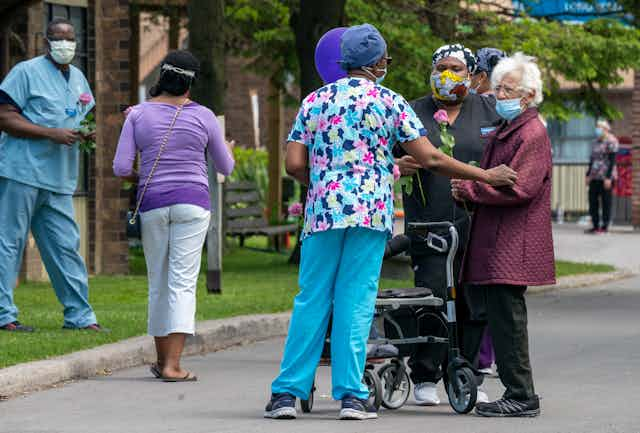The COVID-19 pandemic has amplified public attention to the importance of front-line workers, specifically in the long-term care (LTC) sector where the virus has struck hardest. Most LTC workers were already operating in challenging conditions before COVID-19. But the pandemic has meant watching people in their care endure sharp declines in health and quality of life, and dying during the outbreaks.
Their unique expertise and intimate relationships with the people they support makes LTC workers key intermediaries in the implementation of policies designed to both contain the spread of the virus and maintain a sense of normalcy for care recipients. As a result, LTC workers have been repeatedly heralded as the unsung heroes of the pandemic, or as Québec Premier François Legault prefers, “our guardian angels.”
This connects well with how we, as policy scholars, view front-line workers. We see them as “street-level bureaucrats”: important policymakers whose influence over how policies are implemented can dramatically shape the outcomes, such as the quality of the care residents receive. Occasionally, they use this influence to ignore policy guidelines, but they may also follow guidelines against their better judgment.
Recognizing the importance of their expertise and influence, and the complexity of the decisions they face, we compared how the arrival of COVID-19 affected the daily work of LTC workers in two Canadian provinces (Québec and British Columbia) and two American states (Ohio and Washington) during the first four months of the pandemic.
We identified three types of behaviour: resistance, innovation and improvisation. We found that, despite a rise in media narratives denouncing poor working conditions, official responses to the pandemic continued to undervalue the influence of LTC workers in practice, particularly where cases were highest.
Resistance
In cases where LTC workers decided to act in direct opposition to pandemic policies, we classified their actions as resistance. While absenteeism was a common form of resistance, the most extreme examples involved leaving the job in reaction to new and constantly changing COVID-19 protocols.
Rather than see this behaviour as simply self-serving, it is important to acknowledge the numerous unique stressors that contributed to resistance in the early stages of the pandemic.

Facing shortages of N95 masks and other vital personal protective equipment (PPE), LTC workers faced a higher risk of contracting the virus and spreading it to others. This led to high rates of absenteeism where the risk was greatest, specifically in Québec, which was the hardest hit of the four locations. The staff shortages that followed further heightened pressures on the remaining workers, pushing many to the point of exhaustion.
While resistance narratives were most common in Québec, they occurred in all the states and provinces we examined. Despite comparatively lower infection rates during the first four months in the other three areas, examples of resistance included refusal to adhere to protocols limiting mask use, and protests over PPE shortages. The widespread resistance points to both the lack of pandemic preparedness, and the low status afforded to LTC workers across all locations.
Innovation
Unlike resistance, innovation occurred when LTC workers followed the broad direction of pandemic policy and used their knowledge and expertise to create novel solutions to emergent problems. For example, in B.C., LTC workers were able to overcome the isolation of visitation restrictions and social distancing by quickly setting up video-conferencing for family visits, and doorway bingo as a makeshift recreational activity. These responses exhibited resourcefulness and dedication to the comfort of LTC residents.
In some cases, they also exhibited extreme self-sacrifice, as in Newark, Ohio, where care workers quarantined themselves with residents for 65 days.
These stories are heartwarming, and speak to heroism of LTC workers, but they also demonstrate the flexibility and responsiveness of front-line solutions when workers are empowered with opportunities to act.
Improvisation
Improvisation responses also follow policy guidelines. However, they differ from innovation responses because rather than being empowered to seek ideal solutions, workers are forced to adapt to burdensome limitations. In our study, improvisation responses were most common where working conditions were most challenging and proper equipment was not provided.
Read more: Heath-care workers lacking PPE suffer from more anxiety and depression
Québec once again provided some of the most compelling narratives of improvisation. In one instance, staff working in the “red zone” (for COVID-19 positive residents) of an LTC facility reported having to sew coffee filters into their masks when N95 masks were unavailable. At another point, staff shortages became so severe that remaining LTC staff were forced train replacement workers with limited caregiving experience.
Again, these narratives are striking because of the hardships and grave risks endured by LTC workers, who are forced to compensate for the shortfalls of policies governing their practice.
Recognizing the importance of care work
Much has changed since the first four months of the pandemic. The continuous spread of the disease has affected LTC work across the world, and certainly has diminished some of the differences that we observed between the states and provinces in our study. Innovative ideas have spread too, so that creative solutions for effectively maintaining quality of care, such as safe visitation protocols and recreational activities, have been adopted far and wide.
New policies recognizing the importance of LTC workers have also been adopted, mostly focused on improving pay rates. For example, over the summer, the Québec government actively recruited staff to replenish the LTC sector with promises of increasing wages to $26 per hour. However, few have received this raise, giving them good reason to be skeptical of major reforms to the sector in the immediate future.
Read more: COVID-19 outbreaks in long-term care highlight the urgent need for paid sick leave
This is not for lack of need. Without doubt, the COVID-19 pandemic has accentuated the scarcity of valuable resources in the LTC sector. But it has equally revealed the undervaluation of the sector’s most important resources: its staff. Yes, it is now time to finally sing their praises, but it is also time to finally value their work.


